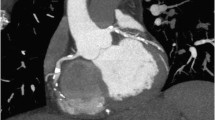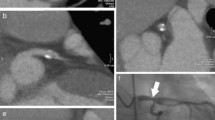Abstract
Sixty four slice coronary computed tomographic angiography (CTA), while traditionally employed as a substitute for stress testing in symptomatic patients, has increasing application in the “asymptomatic” population, and is additive to coronary artery calcium scanning.
-
1.
Patients with atypical symptoms are often misclassified as “symptomatic”; CTA provides accurate information regarding obstruction, as well as risk stratification based on calcified and non-calcified plaque.
-
2.
Using tomographic intravascular analysis (TIVA), CTA provides non-calcified and calcified plaque characterization, similar to intravascular ultrasound. High risk plaques, including thin cap fibroatheromas and plaque rupture, may be identified, as well as totally non-calcified plaque that may or may not result in measurable narrowing.
-
3.
In the truly asymptomatic population, CTA is appropriate in younger patients with a family history of premature coronary disease, in whom coronary calcium screening is not even recommended and whose risk may be established by demonstration of non-calcified plaque. Stress testing is often used for risk stratification in patients with multiple risk factors; CTA is a more appropriate tool and should replace stress testing in this capacity.
-
4.
Totally non-calcified plaque resulting in any measurable narrowing justifies aggressive medical treatment.
-
5.
Non-calcified plaque quantitation and reduction in radiation and contrast will be required for CTA to replace coronary calcium screening.
Similar content being viewed by others
References
Hecht HS, Roubin G. Usefulness of computed tomographic angiography guided percutaneous coronary intervention. Am J Cardiol 2007;99:871–5.
Hecht HS. Applications of multislice coronary computed tomography to percutaneous coronary intervention: how did we ever do without it? Catheter Cardiovasc Interv 2008;71:490–503.
Naghavi M, Falk E, Hecht HS, et al. From vulnerable plaque to vulnerable patient – part III: executive Summary of the Screening for Heart Attack Prevention and Education (SHAPE) Task Force. Am J Cardiol 2006; 98:2H–15H.
Greenland P, Bonow RO, Brundage BH, et al. ACCF/AHA 2007 clinical expert consensus document on coronary artery calcium scoring by computed tomography in global cardiovascular risk assessment and in evaluation of patients with chest pain. J Am Coll Cardiol 2007; 49:378–402.
Executive summary of the third report of the National Cholesterol Education Program (NCEP) Expert panel on detection, evaluation, and treatment of high blood cholesterol in adults (Adult Treatment Panel III). JAMA 2001;285:2486–97.
Grundy SM, Cleeman JI, Merz CN, et al. Implications of recent clinical trials for the National Cholesterol Education Program Adult Treatment Panel III guidelines. Circulation 2004;110:227–39.
Berman DS, Wong, ND, Gransar H, et al. Relationship between stress-induced myocardial ischemia and atherosclerosis measured by coronary calcium tomography. J Am Coll Cardiol 2004;44:923–30.
Raggi P, Callister TQ, Cooil B, et al. Identification of patients at increased risk of first unheralded acute myocardial infarction by electron-beam computed tomography. Circulation 2000;101:850–5.
Arad Y, Goodman KJ, Roth M, et al. Coronary calcification, coronary risk factors, C-reactive protein and atherosclerotic cardiovascular disease events: the St. Francis Heart Study. J Am Coll Cardiol 2005;46:158–64.
Shaw LJ, Raggi P, Schisterman E, Berman DS, Callister TQ. Prognostic value of cardiac risk factors and coronary artery calcium screening for all-cause mortality. Radiology 2003;228:826–33.
Haberl R, Becker A, Leber A, et al. Correlation of coronary calcification and angiographically documented stenoses in patients with suspected coronary artery disease: results of 1,764 patients. J Am Coll Cardiol 2001;37:451–7.
Rubinshtein R, Tamar Gaspar T, Halon DA, et al. Prevalence and extent of obstructive coronary artery disease in patients with zero or low calcium score undergoing 64-Slice cardiac multidetector computed tomography for evaluation of a chest pain syndrome. Am J Cardiol 2007;99:472–5.
Schmeermund A, Baumgart D, Gorge G, et al. Coronary artery calcium in acute coronary syndromes. A comparative study of electron-beam computed tomography, coronary angiography, and intracoronary ultrasound in survivors of acute myocardial infarction and unstable angina. Circulation 1997;96:1461–9.
Pohle K, Ropers D, Maffert R, Geitner P, Moshage W, Regenfus M, Kusus M, Daniel WG, Achenbach S. Coronary calcifications in young patients with first, unheralded myocardial infarction: a risk factor matched analysis by electron beam tomography. Heart 2003;89:625–8.
Morbidity and mortality: 2002. Chart book on cardiovascular, lung, and blood diseases. National Institutes of Health, National Heart, Lung, and Blood Institute. Bethesda, MD.
Schroeder S, Kopp AF, Baumbach A, et al. Noninvasive detection and evaluation of atherosclerotic coronary plaques with multislice computed tomography. J Am Coll Cardiol 2001;37:1430–5.
Caussin C, Ohanessian A, Lancelin B, et al. Coronary plaque burden detected by multislice computed tomography after acute myocardial infarction with near-normal coronary arteries by angiography. Am J Cardiol 2003;92:849–52.
Caussin C, Ohanessian A, Ghostine S, et al. Characterization of vulnerable nonstenotic plaque with 16-slice computed tomography compared with intravascular ultrasound. Am J Cardiol 2004;94:99–104.
Leber AW, Knez A, Becker A, et al. Accuracy of multidetector spiral computed tomography in identifying and differentiating the composition of coronary atherosclerotic plaques: a comparative study with intracoronary ultrasound. J Am Coll Cardiol 2004;43:1241–7.
Achenbach S, Moselewski F, Ropers D, et al. Detection of calcified and noncalcified coronary atherosclerotic plaque by contrast enhanced, submillimeter multidetector spiral computed tomography: a segment-based comparison with intravascular ultrasound. Circulation 2004;109:14–7.
Hausleiter J, Meyer T, Hadamitzky M, et al. Prevalence of noncalcified coronary plaques by 64-slice computed tomography in patients with an intermediate risk for significant coronary artery disease. J Am Coll Cardiol 2006;48:312–8.
Hoffmann U, Moselewski F, Nieman K, et al. Noninvasive assessment of plaque morphology and composition in culprit and stable lesions in acute coronary syndrome and stable lesions in stable angina by multidetector computed tomography. J Am Coll Cardiol 2006;47:1655–62.
Leber AW, Becker A, Knez A, et al. Accuracy of 64-slice computed tomography to classify and quantify plaque volumes in the proximal coronary system. A comparative study using intravascular ultrasound. J Am Coll Cardiol 2006;47:672–7.
Moselewski F, Ropers D, Pohle K, et al. Measurement of cross-sectional coronary atherosclerotic plaque and vessel areas by 16-slice multi-detector CT: comparison to IVUS. Am J Cardiol 2004;94:1294–7.
Caussin C, Larchez C, Ghostine S, et al. Comparison of coronary minimal lumen area quantification by sixty-four-slice computed tomography versus intravascular ultrasound for intermediate stenosis. Am J Cardiol 2006;98:871–6.
Varnava AM, Mills PG, Davies MJ. Relationship between coronary artery remodeling and plaque vulnerability. Circulation 2002;105:939–43.
Kolodgie FD, Burke AP, Farb A, et al. The thin-fibrous cap fibroatheroma: a type of vulnerable plaque: the major precursor lesion to acute coronary syndromes. Curr Opin Cardiol 2001;16:285–92.
Virmani R, Kolodgie FD, Burke AP, Farb A, Schwartz SM. Lessons from sudden coronary death: a comprehensive morphological classification scheme for atherosclerotic lesions. Arterioscler Thromb Vasc Biol 2000;20:1262–75.
von Birgelen C, Klinkhart W, Mintz GS, et al. Plaque distribution and vascular remodeling of ruptured and nonruptured coronary plaques in the same vessel: an intravascular ultrasound study in vivo. J Am Coll Cardiol 2001;37:1864–70.
Sesso HD, Lee IM, Gaziano JM, et al. Maternal and paternal history of myocardial infarction and risk of cardiovascular disease in men and women. Circulation 2001;104:393–8.
Nasir K, Michos ED, Rumberger JAR, et al. Coronary artery calcification and family history of premature coronary heart disease: sibling history is more strongly associated than parental history. Circulation 2004;110:2150–6.
Poon M, Rubin GD, Achenbach SA, et al. Consensus update on the appropriate usage of cardiac computed tomographic angiography. J Inv Cardiol 2007:19:484–90.
Gibbons RJ, Balady GJ, Bricker JT, et al. ACC/AHA 2002 guideline update for exercise testing: summary article: a report of the American College of Cardiology/American Heart Association Task Force on Practice Guidelines (Committee to update the 1997 exercise testing guidelines). Circulation 2002;106:1883–92.
Paul JF, Abada HT. Strategies for reduction of radiation dose in cardiac multislice CT. Eur Radiol 2007;17:2028–37.
Author information
Authors and Affiliations
Editor information
Editors and Affiliations
Rights and permissions
Copyright information
© 2011 Springer Science+Business Media, LLC
About this chapter
Cite this chapter
Hecht, H.S. (2011). Computed Tomographic Angiography. In: Naghavi, M. (eds) Asymptomatic Atherosclerosis. Contemporary Cardiology. Humana Press, Totowa, NJ. https://doi.org/10.1007/978-1-60327-179-0_23
Download citation
DOI: https://doi.org/10.1007/978-1-60327-179-0_23
Published:
Publisher Name: Humana Press, Totowa, NJ
Print ISBN: 978-1-60327-178-3
Online ISBN: 978-1-60327-179-0
eBook Packages: MedicineMedicine (R0)




